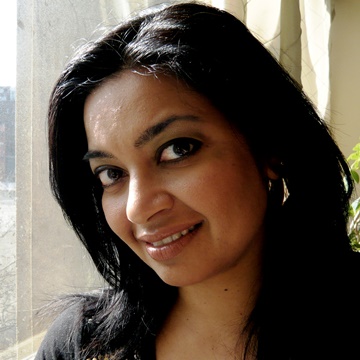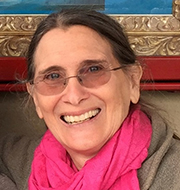
beCause Associate Lina Srivastava interviewed by Henry Jenkins, Professor of Communication, Journalism, and Cinematic Arts at University of Southern California – As my student Geoff Long likes to say, transmedia is an adjective, not a noun, and as such, it needs something to modify. Much of the conversation here has centered around transmedia entertainment, transmedia storytelling, or perhaps transmedia branding and transmedia learning. But, when the word transmedia modifies activism or mobilization, there is no more important voice in the world today than Lina Srivastava. In her hands, transmedia becomes a verb — something we do to make a difference in the world.
I first met her in Madrid several summers ago when we were both speaking at a gathering of thinkers and makers from around the world who were trying to deepen our understanding of what transmedia was and what it could do. I knew her by reputation far before that, and I’ve continued to follow her closely through podcasts, videos, blog posts, op-ed pieces, and projects, ever since. We reconnected not long ago after I got back from India because I knew she had worked so extensively in that region and I wanted to know more about the transmedia campaign she helped to develop around Priya’s Shakti, which we will discuss in more detail in the third installment of this interview. But, our conversation was far reaching, touching on ethical dimensions of the work we do, exploring the challenges of producing media for social change, dealing with how to build structures of participation around documentary and fictional projects alike. When the exchange was over, I asked if she’d be willing to cover some of this same territory for my blog, and she agreed.
So, what follows over the next three installments is a small sample of her passionate and cogent advocacy on behalf of making media that can make a difference in the world.
The term, transmedia, is one which has become increasingly expansive, meaning somewhat different things to different thinkers. Through your work, you’ve talked about transmedia activism. How do you define that concept? Why do you think transmedia is especially valuable as a model for thinking about activism and mobilization?
It’s the combined core of story, community, and collaboration that I seized on the first time I heard and understood the term transmedia. As I thought about the methodology of creating and distributing stories through this framework, I realized the potential for effective social action that emanated from co-creating stories through multiple perspectives that illuminate social, political, and cultural context.
I’ve been working in social impact for fifteen years. The work I do centers primarily with nonprofits and institutions that focus on human rights and international development, or with individual artists and filmmakers who create socially relevant art. Through this intersection, I’ve found that at the very foundation of social change are stories.
And while it appears to me we’ve hit peak noise on discussions of the role of storytelling in social impact, creative expression and culture are still, in my opinion, very underutilized in the social impact fields. We rely heavily on data and policy frameworks, and when we do bring in story, it is still more often to communicate the impact of a program than it is for using it as a strategic driver of change.
You need narrative to spur social action that resonates with and is relevant to communities that are fighting for positive change. You need to know what’s happening at the blood-and-guts-and-feelings level for people – and you need to know what the possibilities and costs to actual human beings are of our policies and actions.
Otherwise, what are we fighting for?
So storytelling, and transmedia in particular, lets me, as a storyteller and a social change agent, illuminate the human side of things.
Activism and mobilization, two distinct ways of effecting social change, at their core rely on community, participation, and collaboration. There’s more to activism or social impact work than these things, of course, but these are essential – and when they are absent, we often get top-down, simplistic, and paternalistic interventions that are ultimately unsustainable because they don’t emerge from perspectives that are based in local contexts.
Beyond that, transmedia has the advantage of allowing for people to travel among multiple entry points and for immersion, both of which are key in allowing for multiple narratives and for complexity.
And transmedia answers the question “how do you tell the story of a system?” There’s a danger in social change when you tell a story from one perspective or from one node in the system. For example, when one thinks about, say, water issues, you may have to think about infrastructure, climate change, safety and security for those getting the water, privatization vs. public access, or sanitation and health, etc. You may work only on one of these aspects, but you have understand how one issue affects the rest and how one shift in the system can change things throughout the system. And you have to know how to tell that story.
True social change comes when solutions are systemic, and transmedia itself – however we define it — has been a social innovation that allows us to view our ecosystem of issues and create stakeholder engagement around systemic change. And one that allows to get into the heart and soul of how these issues affect people and their lives.
So I coined the phrase “transmedia activism” in 2009 to describe this process: The coordinated co-creation of narrative and cultural expression by various constituencies who distribute that narrative in various forms through multiple platforms, the result of which is to build an ecosystem of content and networks that engage in community-centered social.
Another way of saying this is that we use story to effect social change by engaging multiple stakeholders on multiple platforms to collaborate toward appropriate, community-led social action. (And I note, the phrase may specify “activism,” but the framework is meant to be used for various types of social impact or mission-driven work.
I should have been broader when I thought of the term, but this one sounded better than say, “transmedia impact” and I acknowledge its linguistic limitations. And I also will acknowledge here that I don’t always use the term “transmedia” at all when describing my work, as sometimes it’s more appropriate to use alternative terms that will be more easily understood.)
When we build a story universe for social change under this framework, we think first in terms of an ecosystem of issues, social and cultural conditions, communities and solutions– and not only about the narrative arc of the story.
I’m not sure whether my definition works for other thinkers or not. I’ve rarely been one to indulge in discussions around the definition of transmedia, because to me the debate was always a distraction from what I thought to be the core utility of the term, which was to map out a new way of exploring the ways communities were already working together and the ways they were already using culture for to effect social change.
At the time that I was working on the “transmedia activism” framework, about eight years into my work in social impact, discussions around multi-platform narrative as a strategic tool were still fairly nascent in the social impact world, but storytelling per se is not an original concept in social impact.
People had talked about storytelling for years (primarily as an external participatory media was a well-established methodology, and the success of story- and culture-based feedback loops were well-documented. So I wasn’t establishing anything new. I was putting a frame around narrative in a way that plugged into numerous emerging discussions, including social innovation, human-centered design, and digital media, and package those discussions under one frame.
As I read your writing, your concept emphasizes multiple contributing authors working with shared assets, as opposed say to a single author working across media. Why do you find this idea of collaborative authorship important for thinking about social action campaigns?
Collaborative authorship opens up possibilities as I discussed above for multiple perspectives, which is crucial to social action that is grounded in both local context and in larger political or cultural trends. On the creative or artistic side of transmedia, we hear a great deal about the dissolving of boundaries between artist and audience or creators and fans. The analogy for social impact is not one of the taking down of boundaries between various communities and stakeholders.
If we accept that story and media are powerful tools to influence the way people understand issues (knowledge), experience the issues (engagement), see themselves and others in relation to the issues (perception), and what they do to cause these issues to shift (action), then we can see that NGOs and activists who commit to a process through which their various stakeholder communities and influencers take shared ownership of their mission-related story and media, they build an advantage of shared support for their goals, activities and outcomes.
By identifying the narrative underlying the full spectrum of engagement to action, and then by collectivizing ownership of that narrative, transmedia bears the potential to break down the unidirectional construct – “us” helping “them” – that is often at the heart of many traditional aid and international development efforts, instead creating a network of change agents that use narrative as a tool to work toward shared goals, activities and outcomes.
This has the added benefit of having the potential to shake up existing power structures and to move away from paternalistic, patriarchal narrative and design. Transmedia strategies, in allowing diverse and multiple authorship, have the potential to create better streams of participation for community-centered design or “local voice”– i.e., voices coming from an affected community, to tell its own stories and participate in or lead solutions-building.
Lina Srivastava’s interview was originally published on Henry Jenkins’ weblog. He continues his dialogue with her in parts two and three. Lina, founder Strategy for Social Impact, is a strategist combining technology, culture, art, design, and storytelling for social transformation. She is one of a handful in the world creating narrative-based social change initiatives with NGOs, global institutions, and independent media creators, combining field experience with skills in documentary engagement and transmedia design.

